The N10 model Pulsar was introduced to Japan in May 1978, with European sales beginning in March 1979. While known as the Nissan Pulsar in Japan, it was called Cherry in Europe and many other export markets. The body styling was more boxy, and influenced by designs coming out of Europe at that time. It came at a time when small hatchbacks were enjoying rising sales across Europe. It continued to sell well in Britain, and the most popular foreign car there in 1981.
Engine choices were carried over from the previous model, consisting of Nissan’s A-Series motor in 1.0 L, 1.2 L and 1.4 L forms. At some point, the A12 was replaced by the marginally larger A12A in export markets as well. Production of the N10 series ceased in mid-1982, to be replaced by larger N12 Cherry/Pulsar, which was sold in Europe from September 1982.
The N10 model Pulsar, introduced in May 1978, replaced the earlier Cherry F-II internationally, and benefited from the engineering efforts of the Prince Motor Company which developed the Nissan Cherry before the company merged with Nissan in 1966. It retained the rack-and-pinion steering of the Cherry, as well as the independent suspension with coilover struts in front and coil sprung trailing arms at the rear. It retained the Cherry name in Europe and many other export markets, even being sold as the “Cherry Europe” in some markets such as Belgium to separate it from the Cherry F-II which remained on sale for a while. The “Cherry”-badged version was first introduced at the Dutch AutoRAI show in February 1979 and went on sale shortly thereafter. The Pulsar was a subcompact car to augment the Sunny sedan. An unusual styling feature for the car was its long nose, which was due to Nissan envisaging that the car would also be built with a longitudinal rear-wheel-drive layout for developing markets; however, only front-wheel-drive models were actually built. At the time of introduction, the Pulsar only had a four-door fastback-styled sedan bodywork, and either a 1.2- or a 1.4-liter engine. The two-door and the coupé arrived in September 1978. Many export markets also offered a 1.0-liter option, with 45 PS (33 kW) while the 1.2 offered 52 PS (38 kW).
Datsun Cherry wagon (Europe)
The N10 series Datsun Pulsar was exported to Australia (from October 1980 and facelift in October 1981),[4] New Zealand (facelift model locally assembled from late 1981, effectively replacing the previous generation 100A built and sold locally in the mid-1970s), South Africa (locally assembled) and Malaysia with the Datsun Pulsar name. This model was known as the Datsun Cherry or Datsun 100A/120A/130A/140A/150A in Europe and Asia and the Datsun 310 in the US and Canada. The Pulsar was a companion platform to the Nissan Sunny. Both the Sunny and the Pulsar were sold at different Nissan Japan dealerships, called Nissan Satio Shop for the Sunny, and Nissan Cherry Shop for the Pulsar.
The N10 series Pulsar was available as a three- or five-door hatchback, A five-door van or station wagon, and a three-door fastback-styled coupé with a wraparound rear window introduced at the end of 1978. The van was first released in November 1978, while the export-only wagon models first appeared in early 1979.Originally the line up consisted only of the four-door sedan which utilized the same body profile as the later hatchback models; in August 1978 the coupé and three-door hatchback models were added, along with a fuel injected version of the 1.4-liter engine.[6] One year later a five-door hatchback appeared, replacing the four-door sedan which was immediately discontinued.
Most markets outside Japan did not receive all versions: for instance, the three- and five-door hatchbacks and the coupé were the only models to be offered in the US. Most markets never got any fuel injected versions. The 1.0-liter A10 (later also updated to an OHC engine, called E10) was never available in Japan, mainly restricted to markets where tax codes made smaller engines necessary.
A late-term facelift in March 1981 brought Nissan’s newly developed OHC E-series engines in for the last twelve months of production. The facelift involved a new grille and rectangular headlamps. The updated 1982 model Pulsar five-door hatchback with E-series engine was assembled in New Zealand at Nissan’s new factory-owned assembly plant in Wiri, Auckland. Only one well-equipped model was offered, with a five-speed manual gearbox.
In 1982 “Nissan” badges began to appear on the cars, due to Nissan phasing out the Datsun name at that time for its international markets. Production of the N10 series ceased in mid-1982, to be replaced by the all-new N12 Cherry/Pulsar.
In Japan the five-door van received the VN10 chassis code when shown in November 1978, but was then re-released in August 1979 in a version which met the 1979 commercial vehicle emissions standards—this model was designated VN11. While domestic market passenger models only received the slightly larger A12A engine, the vans retained the smaller A12 engine (and the option of the larger A14) as also used in the preceding Cherry F-II. The van was unusual in the Japanese market for the period in being front-wheel drive; Nissan made the most of this and gave it a special rear suspension to allow for a very low loading floor. To further lower the rear opening the rear bumper was also extremely slim. This generation Pulsar van also provided the basis for the first generation of the Prairie people carrier. This van bodywork, with more comfortable fittings, was also used for the wagon model as sold in export markets. After the March 1981 facelift, the van also received the updated E13 and E15 OHC engines and now carried the VUN10 and VMN10 chassis codes.
Overview
Chassis Code N10, N11, VN10, VN11
Manufacturer Nissan
Also called Datsun 100A/120A/130A/140A/150A, Datsun 310 (US), Datsun Cherry (Europe), Datsun Pulsar, Nissan Langley
Production May 1978 – April 1982
Assembly Oppama Plant, Yokosuka, Kanagawa, Japan,New Zealand: Wiri
Body and chassis
Body style
3-door hatchback
3-door liftback coupe
3-door panel van
4-door fastback sedan
5-door hatchback
5-door station wagon
Layout
Transverse front-engine, front-wheel drive
Powertrain
Engine
988 cc A10 I4 (BN10) OHV (In Line 4 Cylinder)
988 cc E10 I4 (SN10) OHC (In Line 4 Cylinder)
1171 cc A12 I4 (N10/N11) OHV (In Line 4 Cylinder)
1237 cc A12A I4 (YN10) OHV (In Line 4 Cylinder)
1270 cc E13 I4 (UN10) OHC (In Line 4 Cylinder)
1397 cc A14 I4 (HN10/HN11) OHV (In Line 4 Cylinder)
1488 cc A15 I4 (Datsun 310) OHV (In Line 4 Cylinder)
1488 cc E15 I4 (MN10) OHC(In Line 4 Cylinder)
Transmission
3/4/5-speed manual (all-synchromesh)
3-speed automatic
Dimensions
Wheelbase 2,395 mm (94 in)
Length3,890–3,940 mm (153–155 in)
Width 1,620 mm (64 in)
Height 1,360 mm (54 in)
Curb weight 840 kg (1,852 lb)
![]()
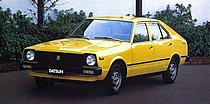
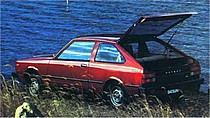
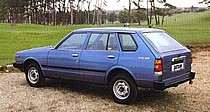
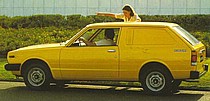
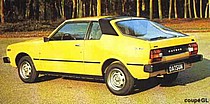

I had 2 Datsun cherry estates that never let me down and a Datsun 140 Y best car I ever had
Thanks for the information. I have a 14OA.
Does it use the same shocks as Nissan Sunny?
So you car is the N10?
Which shocks are you looking for front or rear?
i have a cherry coupe with the e15 engine. i love it but sadly there are now none left. if anybody knows of one say it onb this forum.